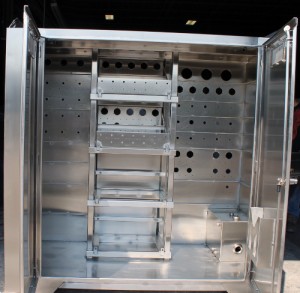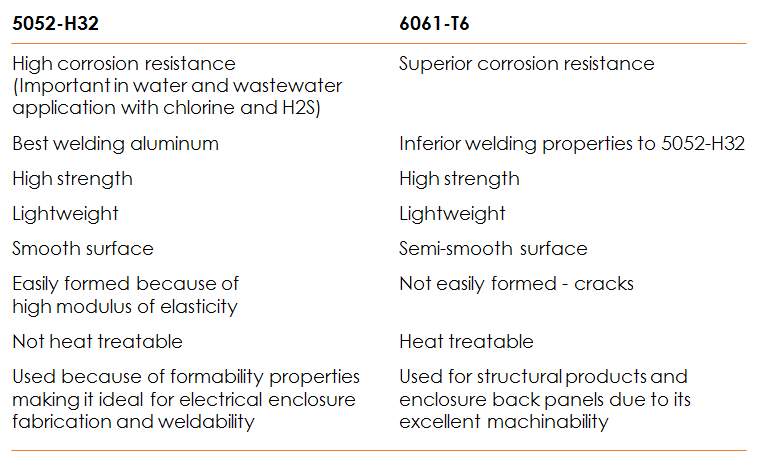-
Recent Posts
- Nema Enclosures Mfg. awarded ISO 9001:2015 re-certification as a Seal of Quality Standard
- NEMA 3RX Rating Now Offered
- NEMA ENCLOSURES MFG. RECEIVES ISO 9001:2015 CERTIFICATION
- Learn about our ATEX & IECEx Ex e Value Added Features and Accessories
- Motor Control Center (MCC) Drop-Over Custom Enclosures
Archives
- May 2021
- February 2021
- July 2018
- October 2017
- September 2017
- April 2017
- January 2017
- December 2016
- March 2016
- February 2016
- October 2015
- August 2015
- July 2015
- May 2015
- October 2014
- August 2014
- June 2014
- April 2014
- March 2014
- February 2014
- September 2013
- August 2013
- July 2013
- June 2013
- May 2013
- April 2013
- February 2013
- January 2013
- December 2012
- November 2012
- October 2012
- September 2012
- March 2012
- February 2012
- August 2011
- May 2011
Difference in Properties & Yield Strength Between 5052 vs 6061
Aluminum alloys are excellent for electrical enclosures that are designed for use in harsh, high heat, high wear conditions typically found in water and wastewater treatment plants. Aluminum alloys are also gentle on the environment.
Aluminum NEMA rated enclosures offer a combination of strength, light weight and corrosion resistance.



Sheet of aluminum Custom aluminum enclosures
Pure aluminum has a high tensile strength. This strength is substantially increased when alloyed with manganese, silicon, copper, magnesium or zinc.
In addition to its strength; attractive finish and an ability to undergo the anodizing process are also great qualities of aluminum.
Aluminum alloys have higher thermal conductivity relative to other electrical enclosure materials, therefore providing superior high heat dissipation.
Many aluminum alloys are heat treatable. Heat treating can alter the mechanical properties of the alloy by manipulating its properties such as the hardness, strength, toughness, ductility, and elasticity.
Aluminum is recyclable with nearly 75% of all aluminum ever produced since 1888 still in use today. Recycling aluminum uses 95% less energy and produces 95% less greenhouse gas emissions than producing metal from new materials.
Aluminum is less expensive than stainless steel, especially when compared to 316 stainless steel.
Aluminum is more durable than carbon and stainless steel.
The superior corrosion resistance quality of aluminum makes it a superior metal for use in industries such water management and wastewater treatment. The reason aluminum resists corrosion so effectively lies in its ability to spontaneously form an oxide layer to prevent further oxidation. Aluminum oxide is impermeable and strongly adheres to its parent metal – unlike the oxides of many other metals. Plus, the aluminum oxide layer will repair itself if damaged.
The layer is stable in the general pH range 4-9.
The chart below shows the relative durability of aluminum in various environmental conditions.

Chart 1: Durability of aluminum in various atmospheric conditions
5052-H32 aluminum alloy or 6061-T6 aluminum alloy for your NEMA rated electrical enclosure – which one is better for you?
The answer is quite simple – only 5052-H32 has the properties suitable for the fabrication of formed electrical enclosures. Let’s compare the two alloys to see why.

Chart 2: Comparison of 5052-H32 and 6061-T6 properties
5052-H32 is optimal for sheet metal work because of its ability to allow for a tight radius while bending.
5052-H32 contains 2.5% magnesium. It is one of the highest strength alloys of the non-heat treatable grades. Common uses for this alloy include the manufacturing of electrical enclosures, marine parts, home appliances, food equipment, fuel tanks, storm shutters, refrigerators, aircraft tube, and fences.
6061-T3 is not recommended for sheet metal work because it will crack on the outside radius once it passes its yield when being processed on a brake press, for example.
6061-T6 is the most commonly used aluminum alloys. The main alloy ingredients are magnesium and silicon. Common uses for this alloy are in the manufacturing of fishing reels, truck frames, structural components, machine parts, aircraft and aerospace components, marine fittings, camera lenses, transport, valves, and couplings.
Both alloys can undergo the anodizing process to increase corrosion resistance and enable dying (coloring). The anodic layer is non-conductive.
5052 is generally less expensive than 6061.
In summary, certain aluminum alloys (especially 5052-H32) are excellent materials for NEMA rated electrical enclosures – especially if your enclosure is going to be used outdoors and/or heat dissipation is a consideration.
This entry was posted in enclosures. Bookmark the permalink.

